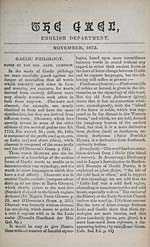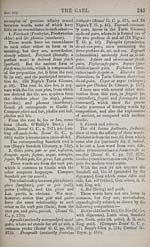Hew Morrison Collection > Gaidheal > 1 Leabh 2 Air
(222)
Download files
Complete book:
Individual page:
Thumbnail gallery: Grid view | List view

244
THE GAEL.
Nov., 1872.
Oirdheirc (excellent). — This word is
derived in the Highland Society's Dic-
tionary from or and dearc ; but the old
forms airdirc, irdircc, erdirc, show that
the first syllable is not br (gold), but the
preposition air, which in composition
appears also as er and ir (Zeuss' G. C.
pp. 5, 8G8).
Inhlnr (confluence). — "NYe have seen
various etymological explanations of
this word, but none which we could
regard as satisHictory. The old form
was Inber (^Stokes' Ir. Glosses, p. 74),
which we regard as containing the
prefix in and the root her, which latter
corresponds, as Avill be afterwards
noticed, to the Gi-eek pher-0 and the
Latin fer-o. Inbhir is, therefore, cog-
nate with iiiferre, one of tiie meanings
of which is " to flow in or into."
Tighearna (lord). — Of this word we
have seen several fanciful etymological
explanations, of which by Air the most
plausible is that which is given in the
Highland Society's Dictionary, and
which connects it with the Gr. turannos.
But the old name Vorticjern, glossed by
architeetor, shows that g, which dis-
appears by aspiration from the modern
pronunciation, is an organic letter, and
points unmistakably to the Lai. tego,
Ger. dach, and Gael, teach, tigh, as
cognates (Stokes' Ir. Glosses, p. 104).
Closely connected with the evil now
referred to, is another against which
the student of Gaelic philology must
carefully guard. "We mean the ten-
dency to draw sweeping inferences from
instances of affinity, which are either
too few or too doubtful to support
general conclusions. Of this crude
mode of philologising, the following
examples of affinity by which, wc
observed .some time ago, a lecturer on
Gaelic philology sought to illustrate a
general statement which he made to
the cflTect that four-fiflhs of the Latin
primitives may be traced to roots which
are also common to the Celtic, may be
taken as a fair specimen: — Aro and
àr, nrco and tart, aridus and lioram,
aries and reithe, arista and dias, diasi,
arma and àrtn.
Ar and aro contain the same root àr,
and are, therefore, closely related ; but
tart and tioram are related, not to areo
and aridus, but to torreo and its cog-
nates, Gr. tersomai, Ger. durst, Eng.
thirst, Sanskrit la7-sh.
If the resemblance between arics,
arietis, and rciihe be sufficient to justify
the inference that these words aro cog-
nates, then must we likewise conclude
that ahies, abielis, and heithe are cog-
nates. But, unfortunately, ahies is not
the birch-tree {beithe), but the fir-tree
{giutìias').
The lecturer seemed to feel that the
resemblance between arista and dias is
not such as to lead at once to the con-
clusion that these words are etymologi-
cally related, for he placed alongside of
dias the form dia&t, which is used in
some parts of the Highlands. But the
t of diast is not organic, as may be
seen by comparing dorus and dorust,
solus and solust, ris and ì'ìst, dithis and
dithist, milis and milist, reubal (rebel)
and reubalt. Besides, dias, not diast, is
the form which we find in ancient
Gaelic (Zeuss' G. C, p. G23).
Arm is probably a loan-word, iden-
tical with the Latin arma (Ebel'a
Celtic Studies by Sullivan, p. 69).
These examples of false etymology
show that, in order to pursue the study
of Gaelic philology intelligently, we
must know : —
1. The oldest existing forms of
Gaelic words.
2. The laws of Gaelic derivation
and composition, that we may be able
to determine with some degree of cer-
tainty the constituent elements, and,
consequently, the roots of the words
of which the language is formed.
o. The laws of letter -change be-
tween Gaelic and its cognate languages.
What we have now stated will be
further illustrated by the following
THE GAEL.
Nov., 1872.
Oirdheirc (excellent). — This word is
derived in the Highland Society's Dic-
tionary from or and dearc ; but the old
forms airdirc, irdircc, erdirc, show that
the first syllable is not br (gold), but the
preposition air, which in composition
appears also as er and ir (Zeuss' G. C.
pp. 5, 8G8).
Inhlnr (confluence). — "NYe have seen
various etymological explanations of
this word, but none which we could
regard as satisHictory. The old form
was Inber (^Stokes' Ir. Glosses, p. 74),
which we regard as containing the
prefix in and the root her, which latter
corresponds, as Avill be afterwards
noticed, to the Gi-eek pher-0 and the
Latin fer-o. Inbhir is, therefore, cog-
nate with iiiferre, one of tiie meanings
of which is " to flow in or into."
Tighearna (lord). — Of this word we
have seen several fanciful etymological
explanations, of which by Air the most
plausible is that which is given in the
Highland Society's Dictionary, and
which connects it with the Gr. turannos.
But the old name Vorticjern, glossed by
architeetor, shows that g, which dis-
appears by aspiration from the modern
pronunciation, is an organic letter, and
points unmistakably to the Lai. tego,
Ger. dach, and Gael, teach, tigh, as
cognates (Stokes' Ir. Glosses, p. 104).
Closely connected with the evil now
referred to, is another against which
the student of Gaelic philology must
carefully guard. "We mean the ten-
dency to draw sweeping inferences from
instances of affinity, which are either
too few or too doubtful to support
general conclusions. Of this crude
mode of philologising, the following
examples of affinity by which, wc
observed .some time ago, a lecturer on
Gaelic philology sought to illustrate a
general statement which he made to
the cflTect that four-fiflhs of the Latin
primitives may be traced to roots which
are also common to the Celtic, may be
taken as a fair specimen: — Aro and
àr, nrco and tart, aridus and lioram,
aries and reithe, arista and dias, diasi,
arma and àrtn.
Ar and aro contain the same root àr,
and are, therefore, closely related ; but
tart and tioram are related, not to areo
and aridus, but to torreo and its cog-
nates, Gr. tersomai, Ger. durst, Eng.
thirst, Sanskrit la7-sh.
If the resemblance between arics,
arietis, and rciihe be sufficient to justify
the inference that these words aro cog-
nates, then must we likewise conclude
that ahies, abielis, and heithe are cog-
nates. But, unfortunately, ahies is not
the birch-tree {beithe), but the fir-tree
{giutìias').
The lecturer seemed to feel that the
resemblance between arista and dias is
not such as to lead at once to the con-
clusion that these words are etymologi-
cally related, for he placed alongside of
dias the form dia&t, which is used in
some parts of the Highlands. But the
t of diast is not organic, as may be
seen by comparing dorus and dorust,
solus and solust, ris and ì'ìst, dithis and
dithist, milis and milist, reubal (rebel)
and reubalt. Besides, dias, not diast, is
the form which we find in ancient
Gaelic (Zeuss' G. C, p. G23).
Arm is probably a loan-word, iden-
tical with the Latin arma (Ebel'a
Celtic Studies by Sullivan, p. 69).
These examples of false etymology
show that, in order to pursue the study
of Gaelic philology intelligently, we
must know : —
1. The oldest existing forms of
Gaelic words.
2. The laws of Gaelic derivation
and composition, that we may be able
to determine with some degree of cer-
tainty the constituent elements, and,
consequently, the roots of the words
of which the language is formed.
o. The laws of letter -change be-
tween Gaelic and its cognate languages.
What we have now stated will be
further illustrated by the following
Set display mode to: Large image | Transcription
Images and transcriptions on this page, including medium image downloads, may be used under the Creative Commons Attribution 4.0 International Licence unless otherwise stated. ![]()
| Early Gaelic Book Collections > Hew Morrison Collection > Gaidheal > 1 Leabh 2 Air > (222) |
|---|
| Permanent URL | https://digital.nls.uk/76797617 |
|---|
| Attribution and copyright: |
|
|---|---|
| Description | A selection of items from a collection of 320 volumes and 30 pamphlets of literary and religious works in Scottish Gaelic. From the personal library of Hew Morrison, the first City Librarian of Edinburgh. |
|---|
| Description | Selected items from five 'Special and Named Printed Collections'. Includes books in Gaelic and other Celtic languages, works about the Gaels, their languages, literature, culture and history. |
|---|

